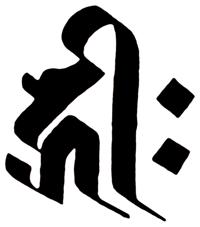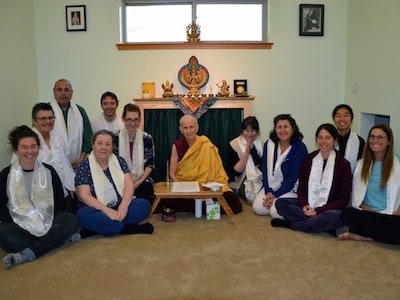Amitabha practice: Refuge visualization
Amitabha practice: Refuge visualization
Part of a series of short commentaries on the Amitabha sadhana given in preparation for the Amitabha Winter Retreat at Sravasti Abbey in 2017-2018.
- A description of the refuge visualization
- Explanation of the various forms of the mantra
- How to visualize Amitabha and the syllables
What I wanted to do, and what I should have done at the beginning, is when talking about refuge describe the refuge visualization. But I didn’t. I just jumped in and talked about refuge.
The visualization for that is you imagine Amitabha’s pure land. Very beautiful place. Waterfalls and meadows. The birds, which are emanations of Amitabha giving teachings and so on. In the center is a precious throne with peacocks…. I’m not sure what the peacocks symbolize. Elephant throne is for strength. Lion’s throne is for a lion’s roar. I’m not sure what peacocks…. Anybody know? (Audience speaks) Oh yes, standing for the bravery of the courageous bodhisattvas who dwell in samsara and liberate sentient beings.
On top of the throne you have a thousand-petalled lotus and a moon disc, and Amitabha sits on top of that. His body is ruby red. His hands are in his lap in meditation position. He’s also holding an alms bowl that is filled with nectar. Similar to how we often see the Buddha sitting. The Buddha’s usually one hand holding the alms bowl, the other in the earth-touching position.
His two arms symbolize love and compassion. He has a slight smile on his face, indicating bliss, contentment, and the fulfillment he experiences as a fully awakened buddha.
Like the setting sun, his warmth pacifies the fear and rigidity of everyone who turns their mind to think of him. So, when your mind gets afraid, when your mind gets rigid, think of Amitabha.
His expression also indicates acceptance, protection, belonging, compassion. Really greeting us with total acceptance and compassion, and including us in the field of his compassion. Nobody is excluded from that. We don’t need to prove ourselves and be better than somebody else in order to be included in Amitabha’s sphere of compassion.
Behind him is the wish-fulfilling tree. He’s seated in the vajra [lotus] position and embodies stillness and peace. On his right side (the left as we look at him) is Chenrezig (in the Chinese it would be Kwan Yin, in Tibetan Chenrezig), who is white and standing on a moon disc and lotus with four arms–two with hands in prayer position, one holding the mala and the other holding the lotus. On Amitabha’s other side (his left, the right as we look at it), in the Chinese Mahasthamaprapta, which means “the arrival of great strength. In China Mahasthamaprapta was usually female. In Tibet she became Vajrapani who is the embodiment of the power (or strength) of the Buddha. So you can see how the name switched to Vajrapani. What’s interesting is that in Chinese Buddhism apparently Vajrapani is one of the incarnations of Mahasthamaprapta. But he’s usually blue. Standing. blue. I think one face, two arms. Maybe holding a lotus….. I can’t remember.
When you do the refuge you imagine–like you always do when you take refuge–your mother on your left, you father on your right, surrounded by all the sentient beings. All the people that you don’t like in front of you. You have to look at them and make peace with them before you take refuge. Then I described the whole process of taking refuge, I summarized it in the first BBC.
After you take refuge, and then after you do the four immeasurables–which I talked about before–then you imagine the whole scene absorbing into Amitabha. Then Amitabha coming to the top of your head. He dissolves into a ball of ruby red light. Then that sinks into you and comes to rest at your heart and really fills your heart center.
Whenever we talk about the heart in Buddhism it doesn’t mean your actual heart (which is off center), it means your heart chakra, the center of your chest.
When Amitabha enters it comes to rest at your heart then you meditate very strongly on feeling Amitabha’s presence, feeling his love and acceptance and compassion, and feeling like your mind becomes the same nature as his. Then also, letting yourself be really filled with bliss when Amitabha dissolves into you. Feel that kind of closeness. And from there you can also go to meditate on emptiness, thinking that Amitabha mind is empty and so is yours. But that is something that you’ll probably do more at the end of the practice after the mantra recitation.
You meditate strongly there and you feel that closeness with Amitabha, then to start the actual practice you again visualize Amitabha, this time on your crown.
The sadhana that we’re doing says:
Visualize the following with single pointed clarity.
Above my crown on a lotus, moon, and sun….
Somehow we got a sun disc in this visualization. This sadhana was written by Lama Yeshe.
Guru Amitabha is sitting on top of your head. The description of the body is the same as before.
His holy body is radiant….
It’s made of light. Don’t visualize Amitabha as a statue or a painting or something solid. The scene in front of you when you take refuge and also now over your head.
He has one face and two hands resting in the gesture of meditation. Holding an alms bowl filled with the elixir of immortality, he wears the saffron robes of ethical purity.
Amitabha, both in the front visualization for refuge, and now the visualization from the actual practice, he’s wearing monastic robes. That’s seeing that Amitabha is in the nirmanikaya form, and Amitayus is in the sambokakaya form. And Amitayus isn’t usually wearing the monastic robes.
His crown is marked by a shining white OM, his throat by a radiant red AH, and his heart by a blue HUM.
Now, in this one it doesn’t say anything about the HRI at his heart, but I think there’s got to be a HRI at his heart. Because HRI is Amitabha Buddha’s seed syllable. So, I found some drawings of it, and I think I solved at least the puzzle I had about Amitabha’s mantra.
Here is what the HRIH looks like in Sanskrit:1

And here’s the mantra (oṃ amitābha hrīḥ) written in Sanskrit.
Here’s the mantra written in Tibetan. The last syllable is the HRIH, so you can see what the HRIH looks like. It’s fairly complex.
You can also visualize H-R-I-H.
And then I found it also in Lantsa and Devanāgarī script.
Now, I don’t know about you, but I always wondered why the mantra was “oṃ amideva hrīḥ.” It seemed funny to me. That’s the mantra that’s in most of the sadhanas, and Pari Rinpoche when he gave it gave “oṃ amitabha hrih soha.”
You know when the Tibetans look at Sanskrit they often don’t pronounce it correctly, in the same way that we don’t pronounce Tibetan correctly and we don’t pronounce French correctly. So this person2, and I agree with this, hypothesizes that the mantra is actually, in the Sanskrit here, is “oṃ amitābha hrīḥ.” The transliteration from the Tibetan is “oṃ amideva hrīḥ.” So the Tibetan, in pronouncing Amitabha, changed the “tabha” into “deva.” In the same way that vajra became bendza. How you got bendza from vajra I don’t know. But it would make sense that from “tabha” you got “deva.”
If you used it like that then it seems like the meaning of “oṃ amideva hrīḥ” would be “undying god.” That’s what his name would mean. But his name is actually “infinite light.” And this person is also saying, “I have also seen Tibetan explanations which say that Dewa (the tibetan spelling) is short for Dewachen the name of Sukhāvatī in Tibetan.”3
But if that were the case then the mantra would be half in Sanskrit and half in Tibetan. And that doesn’t make sense. The mantras are always Sanskrit. It makes much more sense that it’s “oṃ amitābha hrīḥ” and it’s just when the Tibetans were pronouncing it it got changed into “oṃ amideva hrīḥ.”
Pari Rinpoche had the “soha” at the end. I don’t know. There’s probably no fault in saying it. It’s the end of a lot of mantras in Sanskrit.
So, that’s a little bit about the seed syllable.
So, Amitabha’s on the top of your head. So, “from the HUM at his heart….”
And the HUM you can put…. In the HRIH there’s the gigu at the top, you can put a tiny HUM inside of that. Or you can also make the HUM bigger and put the HRIH in the circle at the top of the HUM. Or you can just visualize HUM with a small HRIH on top, or HRIH with a small HUM on top. I don’t think the letters are going to fight it out who’s going to be the center one.
From the HUM in his heart, boundless light shines forth filling all of space. This light especially penetrates Amitabha’s Pure Land, invoking Amitabha Buddha, the eight great lion-like bodhisattvas….
There are eight great bodhisattvas, which I’m going to read the Amitabha sutra later on, it has the names in it.
…as well as the vast assembly of male and female bodhisattvas who reside in the Land of Great Bliss. These all enter Guru Amitabha’s crown chakra, descend his central channel, and absorb into his heart. They are unified and of one nature.
We imagine invoking Amitabha and everybody in his pure land, all those holy beings, and dissolving them into the Amitabha on top of our head that we visualize, and this functions to help us overcome the doubt that this is just an Amitabha that I’ve made up… But no, we’re invoking all of the realizations of all the buddhas in the form of Amitabha and all the bodhisattvas and they’re absorbing into Amitabha. So it’s not just something I visualize. It’s really Amitabha. That helps our own mind.
And then it says,
Hold this thought with single-pointed concentration.
That’s the visualization.
Then we start the part about creating merit and purifying. First we do the seven-limb prayer, which I already described, too.
Now you have to fit together the visualization with what was already described. Hopefully you can do it.
Then we go from there to mandala offering, prostrations, and so on, but we’ll do that tomorrow.
Question: How high above our head should we visualize the lotus, sun, and moon seats?
Venerable Thubten Chodron: Sometimes they say four fingers width. But I think whatever’s comfortable. Not too high, because you want to be able to imagine nectar flowing down fairly easily. Just a little bit above your head.
And as far as how big Amitabha is, some people say visualize small, it helps your concentration. Other people say visualize a cubit. I usually wind up about [six inches]. I think it depends on your own mind, what feels comfortable for you.
Images © Jayarava / http://www.visiblemantra.org. All rights reserved. ↩
Venerable Thubten Chodron
Venerable Chodron emphasizes the practical application of Buddha’s teachings in our daily lives and is especially skilled at explaining them in ways easily understood and practiced by Westerners. She is well known for her warm, humorous, and lucid teachings. She was ordained as a Buddhist nun in 1977 by Kyabje Ling Rinpoche in Dharamsala, India, and in 1986 she received bhikshuni (full) ordination in Taiwan. Read her full bio.




